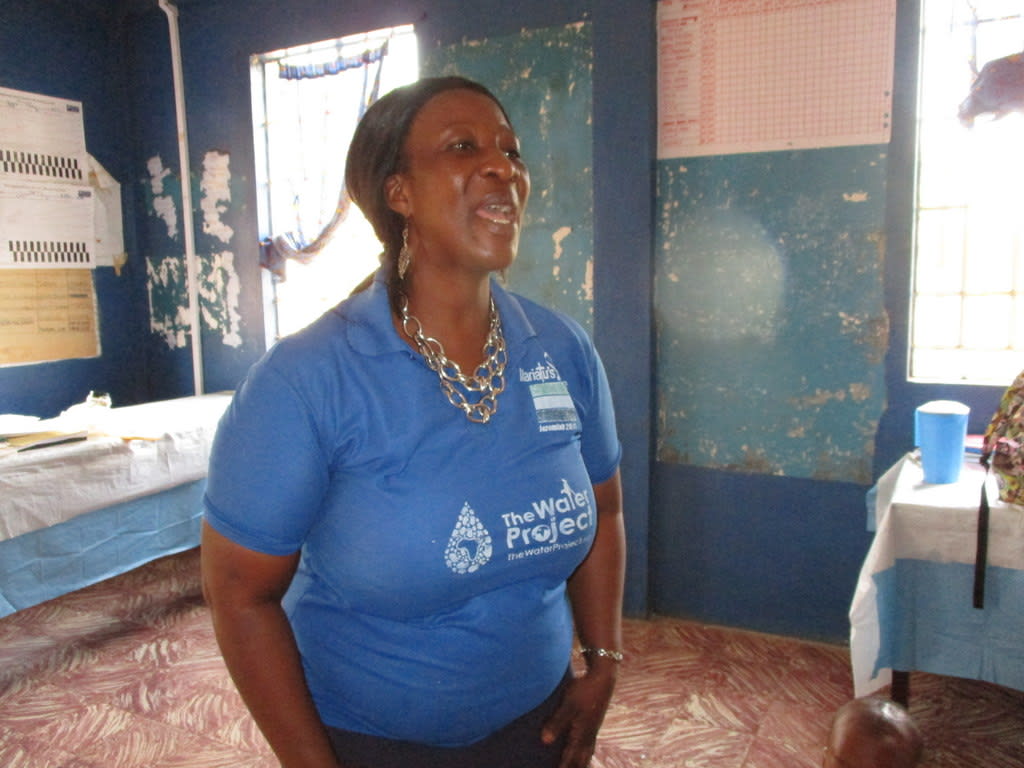New Life Clinic is constructed out of cement blocks and is surrounded by homes made of both mud and cement. This area in Yongoroo, Sierra Leone is lush and swampy and is right across the road from the sea.
The clinic first opened in the 1800s and was headed by a British nurse who went by the name Mrs. Crockson. The clinic is still just as small as it was once it opened: one room for medicine, one for a toilet, and one for patients. There are a few smaller unattached rooms on the property like a dormitory, laundry, and latrines.
It serves areas with a total population of 9,000. The most common case treated is malaria, which is not surprising for a fishing community on the sea. There's lots of dirty, stagnant water where mosquitoes breed.
Water
There is a hand-dug well at the clinic, but it goes dry for at least three months each year. These months, there's no rain to refresh the shallow water table in this well. Staff, patients, and the clinic's neighboring families must find water elsewhere.
Without the clean water this well was supplying, clinic staff and the surrounding community must return to the previous sources they were using.
There's another much more reliable well 350 meters down the busy road. The water is clean, but it is not ideal for clinic staff to have to interrupt the care of patients to go out into the community and fetch water. Children living near the clinic told us that they're afraid to walk far down the busy street to get the water they need.
The clinic, on behalf of their staff and dozens of daily patients, request help to make their well a clean water source that lasts the entire year. They have a system standing by that will allow them to distribute water around the clinic by tap – they just need adequate clean water in the well.
Sanitation
The clinic's hygiene and sanitation situation is stellar, which is a comfort to patients. There are four latrines that are sanitized and covered. There are seven different hand-washing stations available for staff and patients.
"I am personally very satisfied with the hygiene and sanitation in this clinic. As you can see, the whole compound is perfectly kept," Mrs. Bangura, deputy head nurse at the clinic, as she showed us around.
"There are enough hand-washing stations, toilets, a garbage pit, clotheslines, dish racks, and other things. Who wouldn't be jealous of our practices?"
The surrounding community, on the other hand, have latrines made of mud. These are seldom covered or cleaned. Mr. Kamara, a fisherman who lives near the clinic knows about the sharp contrast between his community and the clinic.
"We certainly don't have a perfect smell in this community. Flies are all over the place, and the latrines play a part," he shared.
As a result, the brunt of hygiene and sanitation training will be done with the community members living near the clinic.
Here’s what we plan to do about it:
Training
There will be hygiene and sanitation training sessions offered for three days in a row.
The hygiene and sanitation trainer decided it would be best to teach community members the importance of building good latrines, hand-washing stations, dish racks, and other sanitation facilities. Pictures will be used to teach the community how to discern between healthy and unhealthy hygiene and sanitation practices. The trainer also looks forward to giving the nurses a few sessions to share what they feel is important for their neighbors to learn.
These trainings will also result in a water user committee that manages and maintains the new well. They will enforce proper behavior and report to us whenever they need our help solving a serious problem, like a pump breakdown.
Well Rehabilitation
We found this well has low to dry levels during the driest months of the year. Our team has decided to do the hard job of drilling a borehole by hand in the bottom of this well, which will not only increase the water quantity but will ensure its quality, too. A new well pad will keep contaminants out, and a new India MkII stainless steel pump will provide easy and safe access to the clean water inside.
This clinic and the surrounding community members thought they left the issue of water scarcity behind when they got a well. However, the dry months force them to walk longer distances in search of clean water. By rehabilitating this open well, New Life Clinic and surrounding Yongoroo will be provided with plenty of safe, clean drinking water that persists through the driest seasons.
We are excited to see this well reliably serve New Life Clinic so that they can effectively serve Yongoroo Community.
This project is a part of our shared program with Mariatu’s Hope. Our team is pleased to provide the reports for this project (formatted and edited for readability) thanks to the hard work of our friends in Sierra Leone.

 Protected Dug Well
Protected Dug Well



































